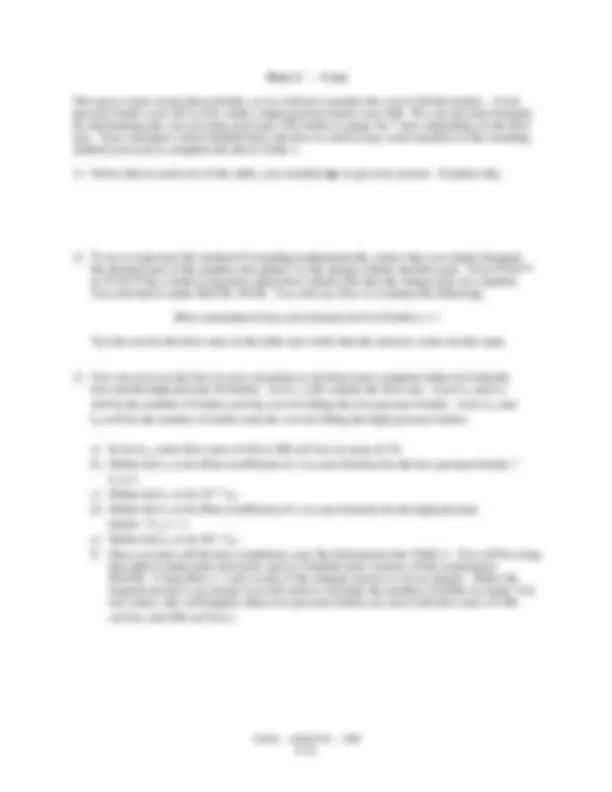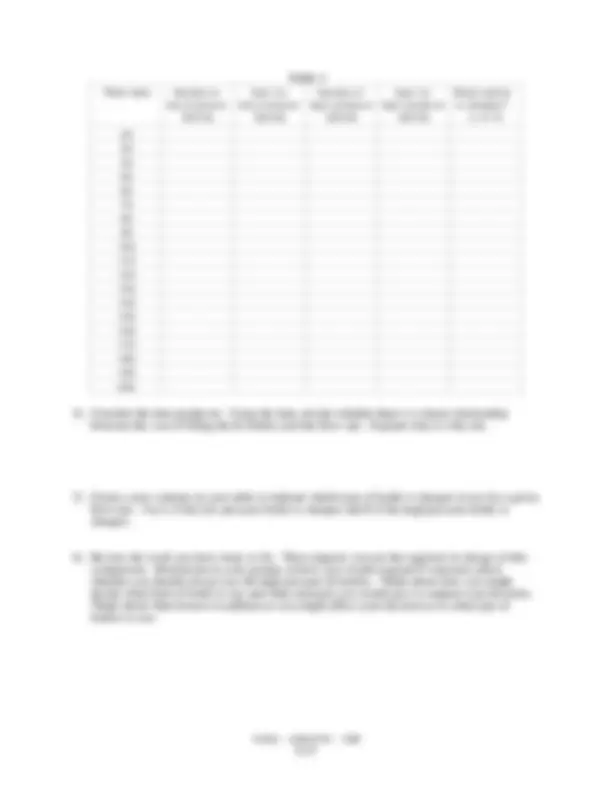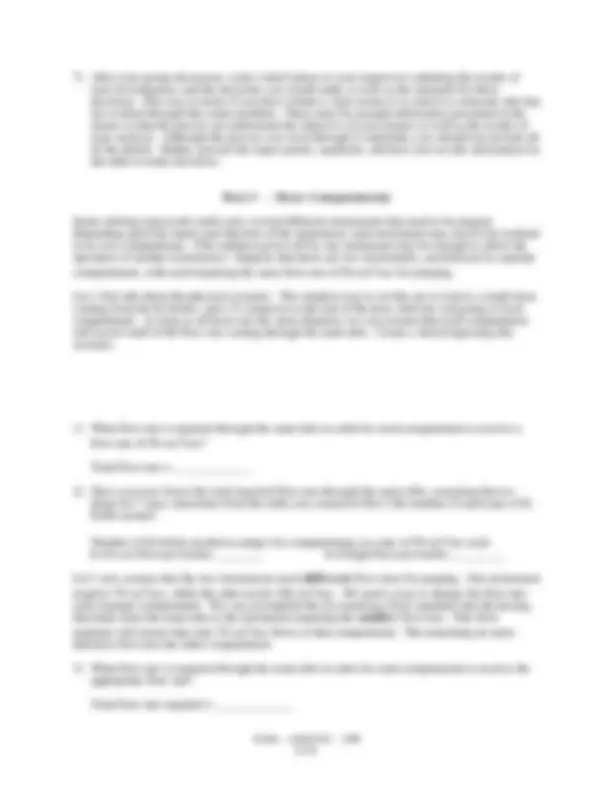





Study with the several resources on Docsity

Earn points by helping other students or get them with a premium plan


Prepare for your exams
Study with the several resources on Docsity

Earn points to download
Earn points by helping other students or get them with a premium plan
Community
Ask the community for help and clear up your study doubts
Discover the best universities in your country according to Docsity users
Free resources
Download our free guides on studying techniques, anxiety management strategies, and thesis advice from Docsity tutors
Instructions for calculating the number of high pressure k-bottles needed for purging at different flow rates, comparing the cost of using high and low pressure bottles, and determining which bottle type is cheaper for given flow rates. The document also includes exercises for creating tables and formulas.
Typology: Study Guides, Projects, Research
1 / 7

This page cannot be seen from the preview
Don't miss anything!




Project Grant Team
John S. Pazdar Peter A. Wursthorn Project Director Principal Investigator Capital Comm-Tech College Capital Comm-Tech College Hartford, Connecticut Hartford, Connecticut
This project was supported, in part, by the Patricia L. Hirschy National Science Foundation Principal Investigator Opinions expressed are those of the authors Asnuntuck Comm-Tech College and not necessarily those of the Foundation Enfield, Connecticut
NASA - AMATYC - NSF
Spinoffs are relatively short learning modules inspired by the LTAs. They can be easily
implemented to support student learning in courses ranging from prealgebra through calculus.
The Spinoffs typically give students an opportunity to use mathematics in a real world context.
Johanna Halsey - AMATYC Writing Team Member
Dutchess Community College, New York
Virginia Lee - AMATYC Writing Team Member
Brookdale Community College, New Jersey
Michael Haddad - NASA Scientist/Engineer
Kennedy Space Center, Florida
At What Cost? High Versus Low Pressure K-Bottles for the Space Shuttle
Part 1 - A Different Kind Of K-Bottle
There are actually two different choices for K-bottles containing compressed air. The one
discussed so far is under a pressure of 2200 lbs/in^2. We will refer to this as the low pressure K- bottle. You can also use a high pressure K-bottle in which the air is under a pressure of 3600
lbs/in^2. The volume of each bottle is still 1.5 ft^3 , but because of the greater pressure, there is a
greater volume of air available at 14.8 lbs/in^2 in the high pressure K-bottle.
Volume of air available at 14.8 lb/in^2 in one high pressure K-bottle = __________ cm^3
Formula for the number of bottles without the 10 % “safety factor” (round to 2 decimal places): _____________
Formula for the number of bottles with the 10 % “safety factor” (use 3 decimal places):
Table 1 Flow rate Whole number of bottles
60 100 120
If you compare the table for the low-pressure K-bottle (refer back to the original LTA, Part 1) and this table for the high-pressure K-bottle, you will see that you need fewer of the high pressure K- bottles for a given flow rate. You might therefore assume that it would be better to always use the high pressure K-bottles. However, it’s time to talk about money.
NASA - AMATYC - NSF
Table 2 Flow rate Number of low-pressure bottles
Cost for low-pressure bottles
Number of high-pressure bottles
Cost for high-pressure bottles
Which bottle is cheaper? (L or H) 20 30 40 50 60 70 80 90 100 110 120 130 140 150 160 170 180 190 200
Consider the data produced. Using the data, decide whether there is a linear relationship between the cost of filling the K-bottles and the flow rate. Explain why or why not.
Create a new column on your table to indicate which type of bottle is cheaper to use for a given flow rate. Use L if the low pressure bottle is cheaper and H if the high pressure bottle is cheaper.
Review the work you have done so far. Then suppose you are the engineer in charge of this comparison. Brainstorm in your groups on how you would respond if someone asked whether you should always use the high pressure K-bottles. Think about how you might decide what kind of bottle to use and what rationale you would give to support your decision. Think about what factors in addition to cost might affect your decision as to what type of bottles to use.
NASA - AMATYC - NSF
Part 3 - More Compartments
Some orbiting spacecraft could carry several different instruments that need to be purged. Depending upon the nature and function of the instrument, each instrument may need to be isolated in its own compartment. (The radiation given off by one instrument may be enough to affect the operation of another instrument.) Suppose that there are two instruments, each housed in separate
compartments, with each requiring the same flow rate of 50 cm^3 /sec for purging.
Let’s first talk about the physical scenario. The simplest way to set this up is to have a single hose coming from the K-bottles, and a T-connector at the end of the hose with one end going to each compartment. As long as all hoses are the same diameter, we can assume that each compartment will receive half of the flow rate coming through the main tube. Create a sketch depicting this scenario.
flow rate of 50 cm^3 /sec?
Total flow rate = _____________
Number of K-bottles needed to purge two compartments at a rate of 50 cm^3 /sec each
Let’s now assume that the two instruments need different flow rates for purging. One instrument
requires 70 cm^3 /sec, while the other needs 100 cm^3 /sec. We need a way to change the flow into each separate compartment. We can accomplish this by inserting a flow regulator into the hosing that leads from the main tube to the instrument requiring the smaller flow rate. This flow
regulator will ensure that only 70 cm^3 /sec flows to that compartment. The remaining air must therefore flow into the other compartment.
Total flow rate required = _____________
NASA - AMATYC - NSF
The numbers within Table 4 represent: _________________________________________
Remember, you cannot attach more than 12 bottles to the manifold on the crawler. What implications does this have for your table? Are all cells in the table valid? Why or why not?
Table 5 Flow Rate for Compartment 1Flow Rate for Compartment 1Flow Rate for Compartment 1Flow Rate for Compartment 1 50 60 70 80 90 100 30 \ \ \ \ \
Flow Rate 40 \ \ \ \ \
for 50 \ \ \ \ \
Compartment 2 60 \ \ \ \ \
70 \ \ \ \ \
80 \ \ \ \ \ \
The numbers within Table 5 represent ________________________________________
10)Finally, use the ideas generated in your brainstorming session to write a report to the team of scientists and administrators. Your report should contain a clear description of how you approached the problem, what information is evident from your tables, and your suggestions for how they can use the tables to make their final decision on what type of K-bottles to use.
NASA - AMATYC - NSF